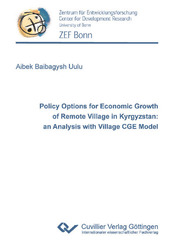| Fachbereiche | |
|---|---|
| Buchreihen (96) |
1378
|
| Nachhaltigkeit |
3
|
| Gesundheitswesen |
1
|
| Geisteswissenschaften |
2364
|
| Naturwissenschaften |
5406
|
| Mathematik | 229 |
| Informatik | 319 |
| Physik | 980 |
| Chemie | 1363 |
| Geowissenschaften | 131 |
| Humanmedizin | 243 |
| Zahn-, Mund- und Kieferheilkunde | 10 |
| Veterinärmedizin | 108 |
| Pharmazie | 147 |
| Biologie | 835 |
| Biochemie, Molekularbiologie, Gentechnologie | 121 |
| Biophysik | 25 |
| Ernährungs- und Haushaltswissenschaften | 45 |
| Land- und Agrarwissenschaften | 1004 |
| Forstwissenschaften | 201 |
| Gartenbauwissenschaft | 20 |
| Umweltforschung, Ökologie und Landespflege | 148 |
| Ingenieurwissenschaften |
1793
|
| Allgemein |
98
|
|
Leitlinien Unfallchirurgie
5. Auflage bestellen |
|
Erweiterte Suche
Policy Options for Economic Growth of Remote Village in Kyrgyzstan: an Analysis with Village CGE Model
Aibek Baibagysh Uulu (Autor)Vorschau
Inhaltsverzeichnis, Datei (39 KB)
Leseprobe, Datei (95 KB)
Since gaining independence Kyrgyzstan has implemented drastic macro reforms to
restructure its economy from the centrally planned type to the one oriented to market
relations. Agricultural sector was always important for Kyrgyzstan’s economy and in
transition agricultural reforms took the form of complete liberalization of the sector and
privatization of the collective farms.
New class of private farmers emerged but is faced with numerous constraints and
problems to ensure stable agricultural food production and maintenance of the livelihood
strategies in rural areas. The hope that as a result of the reforms the efficient markets
would emerge did not materialize. Complete state withdrawal led to underinvestment in
rural infrastructure and failing input and output markets. There is great risk that without
public policies the rural economy of Kyrgyzstan would fall into a situation of persistent
under development and poverty trap.
One of many reasons for the absence of efforts to deal with problems of farmers in the
post reform era has to do with lack of appropriate information on the effect of the reforms
on the rural sector; lack of the knowledge on policy options and policy impacts on private
farmers. This study attempts to fill this gap and contribute to formulating and optimizing
the viable options of rural development strategies.
It is argued that rethinking the role of the state in the post reform period is necessary for
reorienting the public policies away from minimalist toward more activist approach, as
the former is not deemed appropriate under the conditions of the transition economy.
In this study, the village level approach is taken to study the behavior of the rural farm
households in Kyrgyzstan. It is motivated by the distinctive features of the rural sector in
Kyrgyzstan, namely: remoteness; the importance of the village/local economy and
heterogeneity of rural households; the existence of the local linkages between village
households.
The study was based on unique survey data of rural farm households which was collected
by author in a remote village on the South of Kyrgyzstan. The study found that village
households take decision in non separable way, which in turn confirms the fact that in
post reform period farmers are faced with imperfect markets. This highlights the
importance of household non tradables in making production and consumption decisions
of rural households.
This study developed the village social accounting matrix which in quantitative way
demonstrated the heterogeneity of rural households and numerous inter household
linkages that exist in local economy. The distinctive feature of the village SAM used in
this study is in incorporation of the local markets and accounting for non separability of
rural households.
The underdevelopment of the rural sector in Kyrgyzstan is argued to be very much
related to the spatial dimension of the rural areas i.e. lack of access: to markets;
technology; external inputs; capital and limited labor opportunities. Based on this, it is
argued that appropriate rural strategies should involve as central element the easing
geographical and access constraints.
The study employed the village computable general equilibrium (CGE) model to study
the potential effects of the rural policies. It is argued that in the presence of the local
interactions between different farm households, the village CGE modeling approach
yields consistent picture of the production and consumption behavior.
The policy simulation runs showed the impact of policy measures on the levels of
production, income, marketed sale and home consumption. The results seem to provide
support to the policies that aim at improving access to credit, making financial resources
available for increase of household capital stock and at improving access to better
technologies, thus increasing the agricultural productivity of the households. These
policies produced better outcome in terms of production and income growth, while
equally benefiting all household groups. In large extent the findings highlight those
factors that are more constraining and critical to village development (e.g. credit, capital
and new technologies). At the same time, other studied policy instruments like reduction
of transaction costs, external input price subsidies and expansion of labor opportunities
are also highly relevant for the village development, but involve large trade offs in terms
of marketed production and differential income gains for different household groups.
It is believed that these findings would contribute to the efforts of identifying the key
development pathways and sectoral investment priorities that help to launch the village
economy and rural sector of Kyrgyzstan in the direction of sustainable development.
| ISBN-13 (Printausgabe) | 3869552662 |
| ISBN-13 (Printausgabe) | 9783869552668 |
| ISBN-13 (E-Book) | 9783736932661 |
| Buchendformat | A5 |
| Sprache | Englisch |
| Seitenanzahl | 172 |
| Umschlagkaschierung | glänzend |
| Auflage | 1 Aufl. |
| Band | 0 |
| Erscheinungsort | Göttingen |
| Promotionsort | Universität Bonn |
| Erscheinungsdatum | 05.03.2010 |
| Allgemeine Einordnung | Dissertation |
| Fachbereiche |
Land- und Agrarwissenschaften
|








